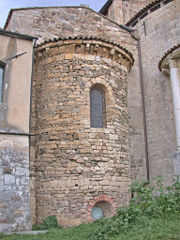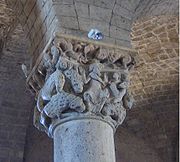
St. Antimo's Abbey
Encyclopedia

St. Antimo Abbey is a former Benedictine monastery, now inhabited by Canons Regular
Canons Regular
Canons Regular are members of certain bodies of Canons living in community under the Augustinian Rule , and sharing their property in common...
, situated in the province of Siena
Province of Siena
The Province of Siena is a province in the Tuscany region of Italy. Its capital is the city of Siena.It has an area of 3,821 km² , and a total population of 252,288 . There are 36 comuni in the province...
, near Montalcino
Montalcino
Montalcino is a hilltown and comune in Tuscany, Italy. It is famous for its Brunello di Montalcino wine.The town is located to the west of Pienza, close to the Crete Senesi in Val d'Orcia. It is 42 km from Siena, 110 km from Florence and 150 km from Pisa...
, Tuscany
Tuscany
Tuscany is a region in Italy. It has an area of about 23,000 square kilometres and a population of about 3.75 million inhabitants. The regional capital is Florence ....
, central Italy
Italy
Italy , officially the Italian Republic languages]] under the European Charter for Regional or Minority Languages. In each of these, Italy's official name is as follows:;;;;;;;;), is a unitary parliamentary republic in South-Central Europe. To the north it borders France, Switzerland, Austria and...
. A tributary of the river Orcia, the Starcia, runs near the abbey.
Its name refers to Saint Anthimus of Rome, whose relics were moved here during the late 8th century. A Bollandist
Bollandist
The Bollandists are an association of scholars, philologists, and historians who since the early seventeenth century have studied hagiography and the cult of the saints in Christianity. Their most important publication has been the Acta Sanctorum...
historian of the 17th century speculated that Pope Hadrian I gave the relics of Saints Sebastian and Anthimus to Charlemagne
Charlemagne
Charlemagne was King of the Franks from 768 and Emperor of the Romans from 800 to his death in 814. He expanded the Frankish kingdom into an empire that incorporated much of Western and Central Europe. During his reign, he conquered Italy and was crowned by Pope Leo III on 25 December 800...
, who then donated them to the abbey when it was founded. But this theory has not yet been verified.http://www.antimo.it/pagine_en/00FRAME.html
History
The origins of the abbey date to a small oratory built here, one the location of a former Roman villa, in 352 at the death of Anthimus. In 715 it was cared by the diocese of ChiusiChiusi
Chiusi is a town and comune in province of Siena, Tuscany, Italy.-History:It was one of the more powerful among the Etruscan 12‑city confederation...
.
In 770 the Lombards commissioned the construction of a Benedictine monastery, which had also to act as a hotel for the pilgrims directed to Rome. In 781, in his trip back from Rome, Charlemagne
Charlemagne
Charlemagne was King of the Franks from 768 and Emperor of the Romans from 800 to his death in 814. He expanded the Frankish kingdom into an empire that incorporated much of Western and Central Europe. During his reign, he conquered Italy and was crowned by Pope Leo III on 25 December 800...
, gave his imprint to the construction, though the version according to which he was the founder of the abbey is most likely a legend. In 814 a document by Louis the Pious
Louis the Pious
Louis the Pious , also called the Fair, and the Debonaire, was the King of Aquitaine from 781. He was also King of the Franks and co-Emperor with his father, Charlemagne, from 813...
made it an imperial abbey. Later the abbot received the title of Palatine Count. At his apex, the abbey possessed 96 castles, terrains and other lands, as well as 85 monasteries, churches and hospitals. Their most important possession was the castle of Montalcino
Montalcino
Montalcino is a hilltown and comune in Tuscany, Italy. It is famous for its Brunello di Montalcino wine.The town is located to the west of Pienza, close to the Crete Senesi in Val d'Orcia. It is 42 km from Siena, 110 km from Florence and 150 km from Pisa...
, which was the abbot's residence.

Vignory
Vignory is a commune in the Haute-Marne department in north-eastern France....
.
In the mid-12th century, halted in its expansion northwards by Florence
Florence
Florence is the capital city of the Italian region of Tuscany and of the province of Florence. It is the most populous city in Tuscany, with approximately 370,000 inhabitants, expanding to over 1.5 million in the metropolitan area....
, Siena
Republic of Siena
The Republic of Siena , was a state originating from the city of Siena in Tuscany, Central Italy.It existed for over four hundreds years, from the late 11th century until the year 1555, when was defeated by the rival Duchy of Florence in alliance with the Spanish crown...
moved its attention to Montalcino. In 1145 the monks were forced to cease the castle of Radicofani
Radicofani
Radicofani is a comune in the Province of Siena in the Italian region Tuscany, located in the natural park of Valdorcia about 110 km southeast of Florence and about 60 km southeast of Siena...
the Sienese. In 1189 Pope Clement III
Pope Clement III
Pope Clement III , born Paulino Scolari, was elected Pope on December 19, 1187 and reigned until his death.-Cardinal:...
placed the pieve
Pieve
In the Middle Ages, a pieve was a rural church with a baptistery, upon which other churches without baptisteries depended.The Italian word pieve is descended from Latin plebs which, after the expansion of Christianity in Italy, was applied to the community of baptized people...
of Montalcino under the bishop of Siena. Filippo Malavolti, podestà
Podestà
Podestà is the name given to certain high officials in many Italian cities, since the later Middle Ages, mainly as Chief magistrate of a city state , but also as a local administrator, the representative of the Emperor.The term derives from the Latin word potestas, meaning power...
of Siena, attacked and partly destroyed Montalcino in 1200. An agreement of 1212 stated that the abbey had to hand over a quarter of its territories to Siena, including Montalcino.
In 1291 Pope Nicholas IV
Nicholas IV
Nicholas IV can refer to:* Pope Nicholas IV * Patriarch Nicholas IV of Constantinople * Patriarch Nicholas IV of Alexandria...
ordered the union of the abbey with the Guglielmites, a reformed branch of the Benictines, in order to give back strength to the abbey. However, after another period of decay in the 15th century, Pope Pius II
Pope Pius II
Pope Pius II, born Enea Silvio Piccolomini was Pope from August 19, 1458 until his death in 1464. Pius II was born at Corsignano in the Sienese territory of a noble but decayed family...
annexed St. Anthimus to the new diocese of Montalcino-Pienza
Pienza
Pienza, a town and comune in the province of Siena, in the Val d'Orcia in Tuscany , between the towns of Montepulciano and Montalcino, is the "touchstone of Renaissance urbanism."...
(1462), whose bishop was Pius' nephew. The abbey decayed to the point that in the 19th century it was used as stable. In 1870s the Italian state restored it.
In 1992 the abbey became again an active monastery with the arrival of a new religious community of Canons Regular
Canons Regular
Canons Regular are members of certain bodies of Canons living in community under the Augustinian Rule , and sharing their property in common...
of the Order of Premontre
Premonstratensian
The Order of Canons Regular of Prémontré, also known as the Premonstratensians, the Norbertines, or in Britain and Ireland as the White Canons , are a Catholic religious order of canons regular founded at Prémontré near Laon in 1120 by Saint Norbert, who later became Archbishop of Magdeburg...
.
Architecture
Of the Carolingian edifice, the apse (called Cappella Carolingia)) and the portal, richly decorated with animal and vegetable motifs, are visible. The Carolingian chapel has frescoes by Giovanni d'AscianoGiovanni d'Asciano
Giovanni d'Asciano, a pupil of Barna of Siena, is said to have completed the frescoes left unfinished by that master at San Gimignano, Tuscany. At Asciano, his birthplace, there is a work by Giovanni, similar in style to the works of Barna. This painter flourished about 1380.-References:...
with stories of St. Benedict and currently acts as sacristy. Under the chapel is a crypt with a nave and two aisles divided by four columns.
The Sala Capitolare (Capitular Hall) is decorated with a triple mullioned window with richly decorated capitals.
Typically French in inspiration is the ambulatory
Ambulatory
The ambulatory is the covered passage around a cloister. The term is sometimes applied to the procession way around the east end of a cathedral or large church and behind the high altar....
with radial chapels. In Italy this scheme is known only in Santa Trinità of Venosa
Venosa
Venosa is a town and comune in the province of Potenza, in the Southern Italian region of Basilicata, in the Vulture area. It is bounded by the comuni of Barile, Ginestra, Lavello, Maschito, Montemilone, Palazzo San Gervasio, Rapolla and Spinazzola....
and the Cathedrals of Acerenza
Acerenza
Acerenza is a town and comune in the province of Potenza, in the Southern Italian region of Basilicata.-History:With its strategic position 800 m above sea-level, Acerenza has been sacked by a series of invaders....
and Aversa
Aversa
Aversa is a town and comune in the Province of Caserta in Campania southern Italy, about 15 kilometres north of Naples. It is the centre of an agricultural district, the agro aversano, producing wine and cheese...
, all in southern Italy, and in Santa Maria of Piè di Chianti, Marche
Marche
The population density in the region is below the national average. In 2008, it was 161.5 inhabitants per km2, compared to the national figure of 198.8. It is highest in the province of Ancona , and lowest in the province of Macerata...
. The ambulatory housed the pilgrims to pray the Martyrium, the place where the Saint's relic are placed.
The aisles and the ambulatory are groin vault
Groin vault
A groin vault or groined vault is produced by the intersection at right angles of two barrel vaults. The word groin refers to the edge between the intersecting vaults; cf. ribbed vault. Sometimes the arches of groin vaults are pointed instead of round...
ed, while the nave has truss
Truss
In architecture and structural engineering, a truss is a structure comprising one or more triangular units constructed with straight members whose ends are connected at joints referred to as nodes. External forces and reactions to those forces are considered to act only at the nodes and result in...
es. The nave, which is c. 20-m high, is divided into three sections: the huge arcades, the matronaeum and the chiaropiano (upper floor).

Master of Cabestany
The Master of Cabestany is the name given to an anonymous sculptor active in the second half of the 12th century. He was identified in the 1930s after the discovery of several pieces remarkable for their workmanship and their style; chief among these was the tympanum of the church in Cabestany,...
. It shows Daniel praying between the hungry lions, and, on the other sides, the lions devouring the accusers.

